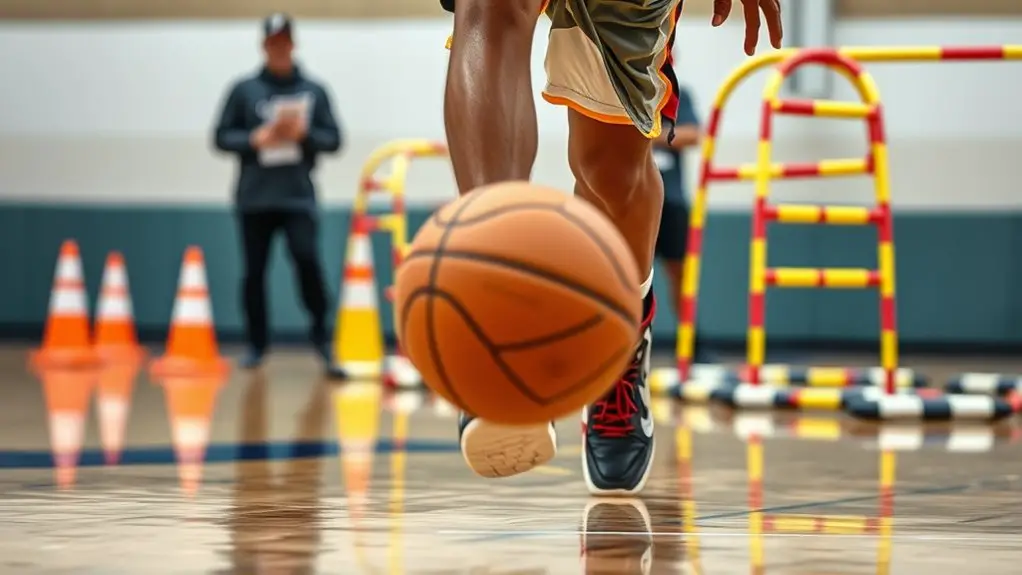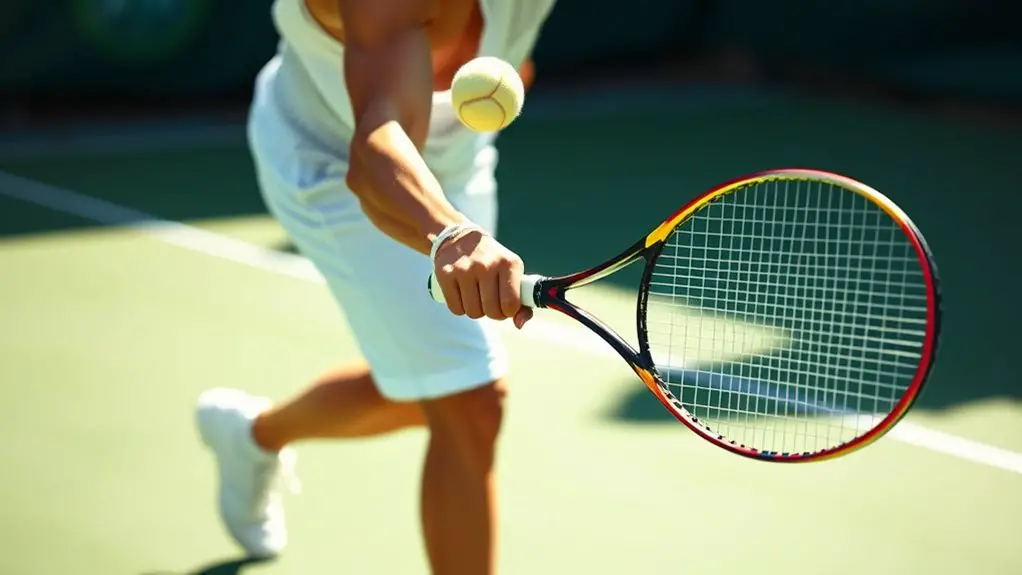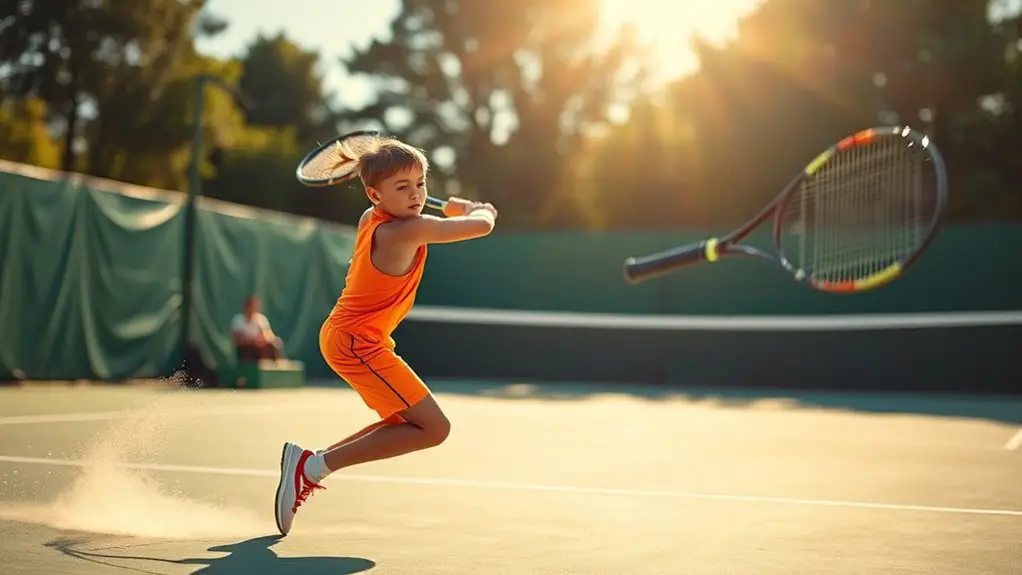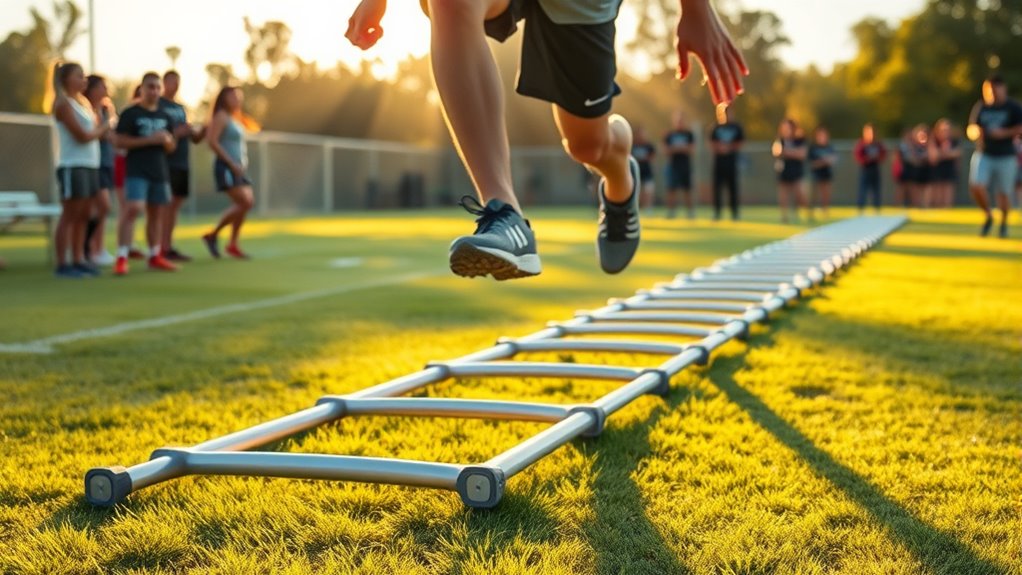To elevate your ball handling to elite levels, mastering advanced dribbling drills is essential. Start with cone dribbling drills to boost agility and precision. Incorporate two-ball exercises to enhance coordination and ambidexterity. Focus on change of pace techniques to keep defenders guessing. Add one-handed drills for better control and dribble relays to improve speed. Reactive drills will sharpen your response time, while isolation scenarios can showcase your creativity. Discover even more techniques to refine your skills.
Importance of Advanced Dribbling Skills
While you might think basic dribbling is enough, mastering advanced dribbling skills is essential for elevating your game. Advanced techniques let you express yourself on the court, giving you the freedom to outmaneuver defenders and create scoring opportunities. It's not just about handling the ball; it's about understanding the dribbling psychology that comes into play when facing opponents.
Skill development in dribbling involves refining your footwork, timing, and spatial awareness. The better you get at advanced dribbling, the more confident you'll feel in your abilities. You'll learn to read the game, anticipate movements, and react with agility. Incorporating agility training techniques can further enhance your dribbling performance during competitive play.
Cone Dribbling Drills
Cone dribbling drills are a fantastic way to enhance your ball-handling skills and improve your agility on the court. By setting up cones with specific cone spacing, you can create various challenges that push your limits. Start with a simple straight line of cones, focusing on quick crossovers as you weave through. Adjust the cone placement to increase difficulty—try tighter spacing for more precision or wider gaps for speed.
You can also incorporate changes in direction, using the cones to simulate defenders. As you progress, experiment with different dribbling techniques, like behind-the-back or hesitation moves, to keep your skills sharp. Remember, the goal is to stay relaxed and fluid while maintaining control. This freedom in movement not only boosts your confidence but also prepares you for real-game situations where agility and dexterity are key. Additionally, these drills can significantly improve overall agility and help you develop the quick decision-making skills necessary for competitive play. So grab those cones and let your creativity flow!
Two-Ball Dribbling Exercises
Two-ball dribbling exercises can take your skills to the next level by improving your control and coordination. As you progress through different difficulty levels, you'll find that mastering key techniques is essential for success on the court. Let's explore the benefits and how to effectively implement these drills into your training routine.
Benefits of Two-Ball Dribbling
Engaging in two-ball dribbling exercises can greatly enhance your ball-handling skills, as it challenges your brain to coordinate simultaneous movements. One of the key two ball benefits is improved hand-eye coordination, allowing you to respond quicker during game situations. You'll also work on your ambidexterity, making you a more versatile player. The constant movement and focus required for two-ball drills push your limits, leading to significant skill enhancement. Plus, it helps develop your ability to protect the ball while maneuvering around defenders. As you embrace this freedom in your dribbling, you'll find your confidence growing on the court. Ultimately, two-ball dribbling exercises can transform your overall play, giving you the edge you need to outperform your competition.
Progression of Difficulty Levels
As you become more comfortable with two-ball dribbling, it's important to gradually increase the difficulty of your exercises to continue challenging yourself. This progression not only enhances your skill progression but also keeps your practice fresh and exciting. Here's a simple table to guide you through progressive challenges:
| Difficulty Level | Exercise Type | Focus Area |
|---|---|---|
| Beginner | Stationary Dribbling | Rhythm and coordination |
| Intermediate | Zigzag Dribbling | Agility and control |
| Advanced | Speed Dribbling | Quick decision-making |
Key Techniques to Master
Mastering key techniques in two-ball dribbling can greatly elevate your overall basketball skills. To start, focus on your ball control. Keep both balls at the same height while dribbling, ensuring that your eyes stay up, not glued to the ground. Practice cross over techniques by alternating the balls in quick succession, mimicking game situations where you need to change direction rapidly. As you gain confidence, incorporate hesitation moves to throw off defenders. Remember, the goal is to develop a rhythm between both hands, allowing for fluidity and creativity. Challenge yourself with different speeds and patterns, and soon enough, you'll see a significant improvement in your dribbling prowess, giving you the freedom to dominate on the court!
Change of Pace Dribbling Techniques
When you're on the court, mastering change of pace dribbling can give you a huge advantage. You'll want to focus on accelerating and decelerating effectively, using explosive first steps to catch defenders off guard. Additionally, incorporating strength training into your routine will enhance your overall performance and stability during these movements. Let's explore some drills that can sharpen these techniques and elevate your game.
Accelerate and Decelerate Drills
Accelerate and decelerate drills are essential for enhancing your change of pace dribbling techniques. Mastering speed variation not only improves your dribble control but also makes you unpredictable on the court. Here are some drills to help you perfect this skill:
- Cone Weave: Dribble through cones, alternating between fast and slow speeds.
- Sprint and Stop: Sprint for a few steps, then suddenly stop and change direction.
- Zigzag Dribble: Move diagonally while alternating between fast and slow dribbles.
- Acceleration Sprints: Start slow, then sprint to the basket, practicing controlled speed changes.
- Reverse Dribbles: Practice dribbling backward at varying speeds to enhance control.
Get creative with these drills, and let your style shine!
Explosive First Step Techniques
A strong first step can make all the difference in your ability to drive past defenders and create scoring opportunities. To develop explosive acceleration, practice launching off your back foot, using your body weight to propel you forward. Focus on quick lateral movements to maintain balance and keep defenders guessing. Incorporate cone drills where you sprint to a cone, then quickly change direction, simulating a game scenario. Remember to keep your knees bent and your head up, staying aware of your surroundings. As you refine these techniques, you'll gain confidence in your ability to break down defenses. Embrace the freedom of movement; let your instincts guide you as you master the art of the explosive first step.
One-Handed Dribbling Drills
Mastering one-handed dribbling is essential for any basketball player looking to enhance their skill set. It gives you the freedom to maneuver around defenders while maintaining one-handed control and one-handed speed. Here are some drills to help you develop these crucial skills:
- Stationary Dribble: Start dribbling with one hand while focusing on control and rhythm.
- Cone Weave: Set up cones and weave through them using one-handed dribbles.
- Wall Dribble: Bounce the ball off a wall with one hand, alternating between left and right.
- Figure Eight: Dribble the ball in a figure-eight pattern around your legs using one hand.
- Speed Dribble: Sprint while dribbling with one hand, maintaining speed and control.
Incorporating these drills into your practice routine will elevate your game, giving you the confidence to handle the ball like a pro.
Dribble Relays for Speed and Agility
Dribble relays are an exciting way to improve your speed and agility on the basketball court. These fun, competitive drills push you to master various dribble techniques while testing your quickness. Start by dividing into teams and setting up a course with cones. Each player must dribble through the obstacles as quickly as possible before passing the ball to their teammate.
Incorporating agility training into these relays helps you develop balance and coordination, essential for effective ball handling. Focus on low, controlled dribbles to maintain speed and guarantee you're ready for any defensive pressure. As you progress, challenge yourself by incorporating different dribble techniques, like crossovers or behind-the-back moves, to keep the drills fresh and engaging. Proper footwork reduces the risk of sprains and ensures you're agile enough to navigate the court effectively.
With each relay, you'll enhance your overall performance, making sure you're not just fast but also agile and skilled when it matters most on the court.
Reactive Dribbling Drills
While you might feel confident in your dribbling skills, adding reactive drills to your practice can elevate your game considerably. These drills sharpen your reaction time and help you handle defensive pressure effectively. By simulating game situations, you'll become more responsive and adaptable on the court. Proper nutrition is vital for enhancing reaction time and overall performance, making it an essential aspect of your training routine.
Here are some reactive dribbling drills to incorporate into your routine:
- Mirror Drills: Partner up and mimic each other's movements.
- Color Calls: Have a coach or partner call out colors for specific dribbling moves.
- Pressure Situations: Practice dribbling while an opponent applies defensive pressure.
- Random Cone Dribbling: Set up cones randomly and navigate through them on cue.
- Obstacle Course: Create a course with various obstacles to react to during dribbling.
Isolation Dribbling Scenarios
When you find yourself in an isolation situation on the court, your ability to navigate through defenders becomes vital. Mastering isolation tactics can give you the freedom to exploit mismatches and create scoring opportunities. Start by making quick defensive reads—identify your opponent's weaknesses and how they react to your movements.
Use hesitation dribbles to keep defenders guessing; a well-timed change of speed can create space. If your defender overcommits, don't hesitate to blow by them. Conversely, if they sag off, utilize a pull-up jumper or a step-back.
Reading the floor is essential; assess help defenders and be ready to kick it out if they collapse. Trust your instincts, and remember, each isolation scenario is a chance to showcase your creativity and skill. Embrace the moment, and let your ball-handling freedom shine! Additionally, adopting a growth mindset can enhance your ability to learn from each isolation experience, ultimately improving your performance on the court.
Incorporating Footwork With Dribbling
Effective footwork is essential for enhancing your dribbling skills, as it allows you to maintain balance and control while maneuvering the court. By mastering footwork fundamentals, you'll improve your balance coordination, enabling you to navigate defenders with ease.
To incorporate footwork with your dribbling, try these key drills:
- Jab Steps: Use quick, deceptive movements to create space.
- Drop Steps: Pivot and change direction swiftly to outmaneuver opponents.
- Shuffles: Move laterally while dribbling to keep defenders guessing.
- Crossovers: Combine footwork with dribbling for explosive changes in direction.
- Reverse pivots: Utilize this move to protect the ball and create new angles.
Frequently Asked Questions
How Often Should I Practice Advanced Dribbling Drills?
How often should you practice advanced skills? Ideally, you should aim for daily practice. Consistency is key to skill progression. Even if you can only spare 20-30 minutes a day, that time will add up. It's about building muscle memory and confidence. Don't feel pressured to overdo it; listen to your body and enjoy the process. The more you practice, the more freedom you'll feel on the court. Keep pushing yourself!
What Age Is Appropriate for Starting Advanced Dribbling Drills?
When it comes to nurturing your budding athlete's potential, starting advanced drills typically welcomes kids around ages 10 to 12. At this stage, they're ready to embrace skill progression while enjoying the freedom to express themselves on the court. Youth development thrives when they're encouraged to explore and refine their abilities. By introducing advanced concepts early, you're setting the stage for future excellence and empowering them to take charge of their own growth.
How Can I Track My Dribbling Improvement Over Time?
To track your dribbling improvement over time, you can establish dribbling metrics and set performance benchmarks. Keep a journal of your practice sessions, noting things like dribble speed, control, and variety of moves. Use video recordings to visually assess your progress. By regularly comparing your current performance to past benchmarks, you'll see how far you've come and where you can still grow. Embrace this journey; it's all about freedom and expression on the court!
Are There Specific Shoes Recommended for Better Ball Handling?
As they say, "The right shoe can take you places." When it comes to ball handling, you'll want shoes with excellent grip technology and supportive shoe features. Look for rubber outsoles designed for traction, as they'll help you pivot and change direction smoothly. A lightweight, breathable design can also free up your movements, allowing you to dribble with confidence. Investing in the right footwear will elevate your game and keep you agile on the court.
Can I Perform These Drills at Home Without a Court?
Absolutely, you can perform these drills at home without a court! Just make sure you've got enough space to move around. Clear an area where you can dribble freely, avoiding any obstacles. Home drills can be just as effective; focus on your footwork and control. You don't need fancy equipment—just a ball and your determination. Embrace the freedom to practice anywhere, and you'll see progress in your skills!




